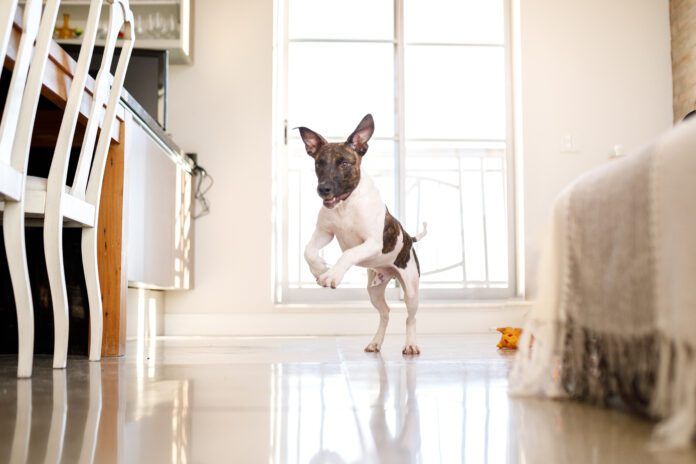
Taking care of a dog in an apartment can be complicated. Apartments often have limited outdoor areas for dogs to run in, less indoor space to play or train in, and a plethora of human and canine neighbors to try to get along with. That said, don’t give up hope! Most types and sizes of dogs can do well in apartments provided they get the right amount of exercise and mental stimulation.
That said, there are some things to consider when bringing a puppy to live with you in an apartment or moving to an apartment with a dog.
What Kinds of Dogs Do Well in Apartments?
While apartment living is possible with most dogs, it is significantly easier to find a place to rent and live there comfortably with a smaller, lower-energy dog. Limited space is one of the biggest challenges for dogs living in apartments. The more space the dog needs, the harder it is to get that need met in a small rental, especially when the weather gets bad.
It’s also worth noting that dogs who are comfortable with people and other dogs tend to be a better fit for apartment life. In addition to much more human activity than living in a house, dog-friendly apartment complexes often have a lot of dogs in residence. While socialization and training can help, having doors opening, people walking by at all hours, and strange dogs everywhere can be hard on dogs who are reactive or those who prefer to have some space between themselves and the neighbors.
If you are looking to get a specific breed of dog, do your research. Small dogs aren’t always low-energy—just ask anyone with a Jack Russell. If you’re looking to adopt a dog, consider an older dog. Not only will the dog be done growing, you’ll also have a better sense of whether they will be the right fit for apartment life.
How to Have a Big Dog in an Apartment
Large, high-energy dogs need a lot more from their owners when confined to a small apartment, mostly due to their exercise needs. While a tiny Toy Poodle may be able to get enough exercise running laps around the kitchen island, that probably won’t work for a Belgian Malinois. If you have a big dog, plan for multiple daily walks, keeping in mind that you will never be able to skip the walk in favor of letting the dog out in the yard to run.
In addition to walks, it helps to have some strategies for exercising your dog indoors. These can include activities like hallway walks, puppy push-ups, and (if space and non-skid floors allow) treat chasing. For more on how to exercise and play with your dog inside, see “How To Entertain Your Dog at Home.”
Becoming a member of a club or signing up for classes that focus on dog sports such as agility, flyball, or dock diving can also be a good way to keep a big dog happy in an apartment. Not only will these activities keep your dog well-exercised, they can also be a fun, mentally stimulating outlet for you both. As always, check with your vet to be sure your dog is healthy enough to participate before getting started.
If you have a dog who likes to socialize and can find a doggy daycare you trust, consider dropping your dog off for playtime several days a week to help meet her exercise needs. Good daycares usually keep group sizes small, provide a variety of activities mixed with rest times, and emphasize matching dogs with the right playmates.
While not specific to living in an apartment, keep in mind that dogs—big and small, high- or low-energy—need regular mental stimulation. Bored dogs are far more likely to develop unwanted behaviors, which can be particularly difficult in an apartment since excessive barking or destructive chewing can become big issues with fellow tenants and landlords. For some tips on providing good mental stimulation for your dog, check out “The Importance of Mental Stimulation for Dogs.”
Common Dog Restrictions When Renting An Apartment
When it comes to renting an apartment with a dog, remember that even places which allow pets typically have restrictions. These can include:
- Weight: Rental properties regularly have pet weight restrictions with 50- and 25-pound limits being the most common. While rental agents probably won’t pull out a scale to weigh your dog, they will check the dog’s vet records to verify her size.
- Number of pets: Most rentals that allow pets have a two-pet limit. Having more than two can make it much more difficult to find an apartment.
- Age: Though less common than other restrictions on this list, rental properties occasionally won’t accept dogs under 1 year old.
- Unvaccinated pets: Rental apartments often have vaccination requirements for any dog living on the property. If your dog cannot receive a required vaccine—even for a medically significant reason such as an allergy—or if you prefer to do vaccine titer tests rather than having your dog vaccinated on a set schedule, you may run into trouble when trying to rent.
- Breed: Some rentals, particularly larger, company-managed apartment complexes, have breed restrictions. These restrictions, which seem to stem from public perception and perceived liability, usually target so-called “aggressive” breeds such as Pit Bulls and Rottweilers. This can extend to banning any dog that appears to be a mix of a banned breed.
One potential trouble spot when living in an apartment that has these types of restrictions can be getting a puppy whose genetic background is unclear. If one or both of a puppy’s parents are a mystery, it can be very hard to tell how big she might get or what she will look like as an adult—even with DNA testing. A dog who was allowed in an apartment as a puppy might become a lease violation when she grows bigger than expected or starts to resemble a banned breed. Some landlords might be understanding and grant an exemption, but they are not required to do so. Lease terms can be unforgiving—and very difficult to appeal. If you are found to have a pet that is not in compliance with the lease terms, you could be required to remove the animal from the property within 24 hours of notification.
In short, it is important to thoroughly read and understand the pet policy at any rental property you are considering moving into with a dog. Get a copy in writing and check that the lease terms match both the written pet policy and what you have been told. Once signed, the lease and any addendums attached to it are a legally binding agreement. It doesn’t matter if a leasing agent or landlord told you “Oh, we never enforce that clause. It’ll be fine.” They can still enforce anything you agreed to when you signed.
Additional Expenses When Renting with a Dog
Having a dog in an apartment can come with extra expenses. Many apartments require a pet deposit in addition to the security deposit. The amount varies but is usually at least $300. Monthly “pet rent” fees are also common. These can range from as little as $10 a month per pet to over $100 a month per pet. When moving out of an apartment, some rentals require an extra cleaning fee. This fee is typically assessed for any unit where pets lived and isn’t based on damage.
If your dog does damage anything while you are living in an apartment, assume you will have to pay for it. That said, some renter’s insurance will cover pet damage, so be sure to check your policy before paying out of pocket.
Special Considerations for Living in an Apartment with a Dog
There are a few final things to note before moving into an apartment with a dog:
- Training is important for any dog, but it is perhaps even more so for dogs living in an apartment. Outside of apartment living, very few circumstances expose dogs to so many people and pets living so close. Good manners not only make apartment life easier for you and your dog, they also make it safer for the dog.
- As discussed in “How To Potty Train a Puppy in an Apartment,” house training a dog in a big apartment complex can be a challenge due to the distance between the living space and the outdoors. Make a plan and get any necessary supplies before the dog arrives.
- Expect the company or landlord to require a copy of your dog’s vet records. You may also be asked to verify your dog’s behavioral history. Be honest. If it is discovered that inaccurate information was given, you could be asked to remove the dog from the property immediately.
- Consider getting your dog’s AKC Canine Good Citizen (CGC) title. Some rental properties give discounts to dogs with a CGC.
- Crate training is pretty much essential for a dog living in an apartment. It’s common for maintenance workers to need to enter the unit to do regular upkeep or respond to resident requests. Even if you can be home every time someone needs to enter the apartment, it is still easier and safer if your dog can wait comfortably in her crate while people (who may not be comfortable with dogs) are in and out.
While the requirements associated with having a dog in an apartment may sound daunting, it’s not all bad! Many dog-friendly rentals offer great amenities such as on-site dog washrooms, dog parks, and pet-centered community events. As with any other living arrangement, the trick is to understand the challenges and assess what your dog needs to be happy, safe, and healthy.


